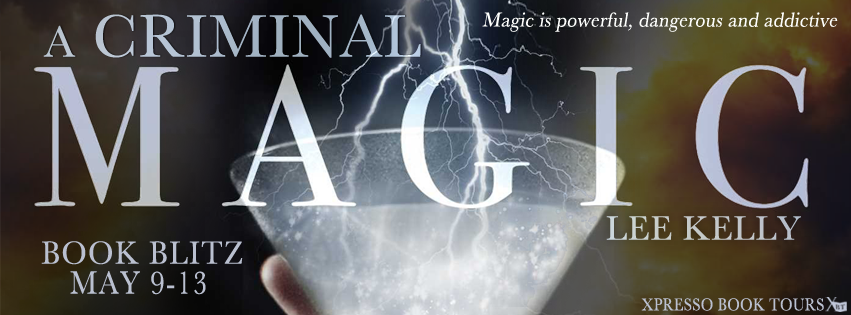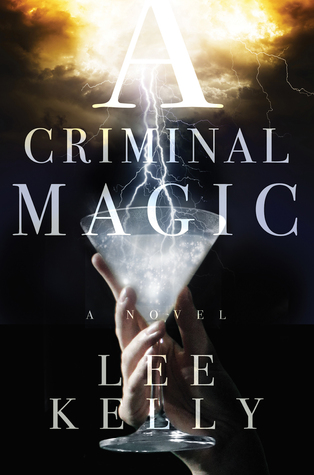
Novels and Necklaces is extremely excited to participate in the Book Blitz for Lee Kelly's A Criminal Magic! Today we have an interview and guest post with Lee Kelly, and an awesome giveaway! This book sounds amazing, so definitely add it to your TBR asap :)

A Criminal Magic
Lee Kelly
Publication date: February 2nd 2016
Genres: Fantasy, Historical, Young Adult
THE NIGHT CIRCUS meets THE PEAKY BLINDERS in Lee Kelly’s new crossover fantasy novel.
Magic is powerful, dangerous and addictive – and after passage of the 18th Amendment, it is finally illegal.
It’s 1926 in Washington, DC, and while Anti-Sorcery activists have achieved the Prohibition of sorcery, the city’s magic underworld is booming. Sorcerers cast illusions to aid mobsters’ crime sprees. Smugglers funnel magic contraband in from overseas. Gangs have established secret performance venues where patrons can lose themselves in magic, and take a mind-bending, intoxicating elixir known as the sorcerer’s shine.
Joan Kendrick, a young sorcerer from Norfolk County, Virginia accepts an offer to work for DC’s most notorious crime syndicate, the Shaw Gang, when her family’s home is repossessed. Alex Danfrey, a first-year Federal Prohibition Unit trainee with a complicated past and talents of his own, becomes tapped to go undercover and infiltrate the Shaws.
Through different paths, Joan and Alex tread deep into the violent, dangerous world of criminal magic – and when their paths cross at the Shaws’ performance venue, despite their orders, and despite themselves, Joan and Alex become enchanted with one another. But when gang alliances begin to shift, the two sorcerers are forced to question their ultimate allegiances and motivations. And soon, Joan and Alex find themselves pitted against each other in a treacherous, heady game of cat-and-mouse.
A CRIMINAL MAGIC casts a spell of magic, high stakes and intrigue against the backdrop of a very different Roaring Twenties.
—
GUEST POST by LEE KELLY:
GANGSTERS!
Real-Life Gangsters that Inspired the Tough Guys in A CRIMINAL MAGIC
The pitch for my latest book, A CRIMINAL MAGIC, is THE NIGHT CIRCUS meets THE PEAKY BLINDERS, and for anyone who’s seen that twisty, violent BBC drama, you’ll know this means there’s some pretty hardened criminals in this one. My story takes place during an alternative Prohibition-era America, but instead of alcohol, magic has been prohibited. And just like during real Prohibition, gangsters have created an extensive, lucrative underworld to make sure people still get what they want, despite the letter of the law.Real-Life Gangsters that Inspired the Tough Guys in A CRIMINAL MAGIC
Because the magic in this novel is tricky and dangerous by nature, I knew I needed gangsters that weren’t just ruthless – these wise guys had to be clever, driven, and one step ahead of the sorcerers they employ in all aspects of their illegal trade. For inspiration and ideas, I naturally turned to history. Here are some of the notorious, hardnosed gangsters that most inspired me while writing A CRIMINAL MAGIC:
Owen “Owney” Madden was a New York gangster nicknamed “the Killer,” and aptly so as he was known for his very public executions. Madden more than once gunned down his rival gang members in the streets, and he allegedly shot a man on a trolley for flirting with his date. Despite being a hothead, he was also a shrewd businessman, and ran The Cotton Club (as well as some other swanky speakeasies) in New York City. In my novel, Erwin McEvoy, the boss of the Irish Shaw Gang, is loosely based on Madden (with a little Boo Boo Hoff thrown in there too. Boo Boo’s up next).
I have to admit, I was first attracted to Max “Boo Boo” Hoff because of his name, but the more I read about this Philly-based crime boss, the more fascinated I became. Hoff was a boxer turned gangster, and his bootlegging operation was so successful during Prohibition, it’s claimed he had an office of operations with 175 phones and a weekly payroll of $30,000 (in the 1920s)! Also known for his partying and extravagant lifestyle, Hoff frequently rubbed shoulders with celebrity types at his lavish affairs.
Also intriguing was Guiseppe “Joe the Boss” Masseria, the head of the New York Italian-American mafia – the city’s powerful crime alliance known as the Five Families – during the later years of Prohibition. But Masseria was a bit of an underworld dictator: he even required monetary tributes from other Families as testaments of their loyalty. His reign naturally didn’t last: several families declared war on Masseria, which broke up the crime dynasty and led to his execution. I loosely based my novel’s Italian-American gang, the D Street Outfit, on Masseria’s New York operation.
And of course, no list of Prohibition-era gangsters would be complete without Al Capone. Though my novel’s young gangster-on-the-rise, Harrison Gunn, is actually nothing like media-hungry Capone was, I couldn’t believe that Capone was at the height of his power and became a Chicago crime boss in his mid-twenties. So I made Gunn younger (originally he was going to be middle-aged), to help rev up the tension between him and my female protagonist, Joan.

Author Bio:
Lee Kelly has wanted to write since she was old enough to hold a pencil, but it wasn’t until she began studying for the California Bar Exam that she conveniently started putting pen to paper. An entertainment lawyer by trade, Lee has practiced law in Los Angeles and New York. She lives with her husband and children in Millburn, New Jersey, though after a decade in Manhattan, she can’t help but still call herself a New Yorker. She is the author of A Criminal Magic and City of Savages. Visit her at www.NewWriteCity.com.
Author Interview:
What
do you think is your lead character’s best trait?
I’d
say Alex’s best trait is his ability to read people – he ends up being very
good at undercover work because of his sensitivity to human interactions, emotions
and experiences. And Joan’s best trait
is her relentless commitment and determination – to her family at the outset,
and eventually, to her work within the Shaw Gang. Ironically I guess both Joan’s and Alex’s
“best traits” can also be “worst traits” given the context.
Are
there any characters in your book based on a real person?
Not
directly, I guess – though Harrison Gunn is actually named after my friend and
old co-worker, who insisted that I name a character after him in this novel (so
take the bad guy Harrison J)! Most of the characters in the book are my own
creations or some kind of combination of multiple people: like Alex is sort of
a combination of me and my husband, while Joan is a combination of me and my
sister.
What’s
something your readers would be surprised to know about you?
I’m
strangely superstitious, or at least I used to be. I’ve stopped most of these superstitious
“rituals,” but I used to have to turn the lights off three times before leaving
my apartment or I’d think I’d have a bad day, or I’d have to wear a certain pair
of earrings to an interview.
Where
is your favorite place to write?
The
place I always write is the office off my bedroom, so I guess that’s my default
answer. But I really enjoy writing on
the second floor of my town library, Millburn Library, because of the views of
the woods – and I love those moments when I’m away from my everyday life and
actually get in some writing time… like my parents’ kitchen table during the
holidays before anyone gets up, or on vacation while my husband and kids sleep
in. It feels like I’m sneaking out on a
date with my characters.
What
did you want to be when you grew up?
A
writer – though the answer briefly changed to archeologist after I watched the Indiana Jones trilogy.
What
is your favorite book of all time?
I’d
have to say The Phantom Tollbooth. I think the books you read as a child have a
way of staying with you.
Describe
your writing style in three words.
Character-driven,
otherworldly thrillers.
It’s
evolved, for sure. Before City of Savages, I had a really hard
time finishing anything: I was a perfectionist, and needed each chapter to read
complete and final before I moved on to the next. But sadly, after the
first twenty pages of a manuscript, I'd clam up and start worrying that I’d
make a mistake.
Eventually,
I realized that the only way to overcome the fear of imperfection was just to
submit to it: my first drafts were going to be messy. So now I write
“with a spit and a polish.” I'll
initially draft a passage or a chapter really quick and messy – sometimes with
just sketches of ideas – and then the next day, I usually polish the previous
day's installment so it's a little more readable. But after that quick one-two, I move forward
with the story without any more second-guessing.
After
I’ve completed a first draft, I step away from it completely for a couple weeks.
When I begin the second draft, I let that “perfectionist” sit down at the
computer. Draft two is more like rewriting than revising, but that's
okay, as writing is less scary when I have 85,000 or so words under my belt
(even if they're the wrong words). My third draft involves input from
beta readers and critique partners, followed by another fairly full-scale
revision.
~Cassie



No comments:
Post a Comment